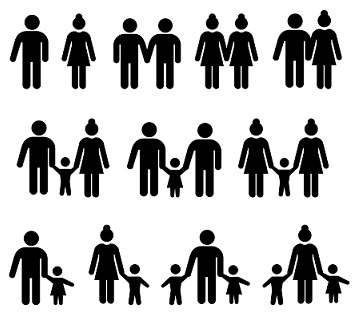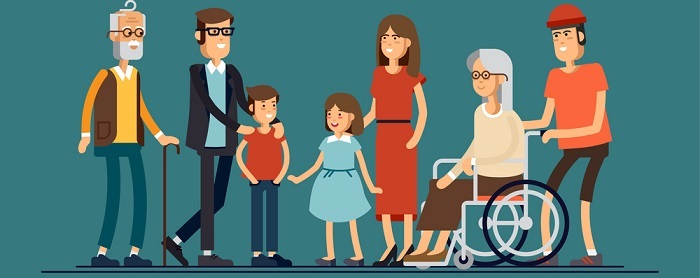

The concept of family, household, and domestic groups is central to anthropology. These social institutions play a significant role in shaping the lives of individuals and societies as a whole.

The family is a universal institution, and its importance lies in its ability to fulfil a variety of functions critical to the survival of individuals and society as a whole, which include −
Socialisation: The family is responsible for socialising children, teaching them the norms, values, and traditions and to make them functional members of society.
Economic Support: The family also provides economic support to its members like food, shelter, and clothing.
Emotional Attachment: The family is a source of emotional attachment and support as it provides comfort and companionship, and they help each other through difficult times.
Reproduction: One of the primary functions of the family is to ensure the continuation of the species. Families provide a framework for sexual reproduction and childbearing.
Anthropologists have identified several different forms of family organisation that vary widely across cultures and historical periods −
Nuclear Family: It consists of parents and their children living together in a single household.
Extended Family: A group of relatives who live with the parents and kids in the same home, in addition to grandparents, aunts, uncles, and cousins.
Matrilineal Families: Those in which property rights and inheritance are handed from mother to daughter through the mother's line of ancestry.
Patrilineality: It carries inheritance and property rights from father to son and may be identified by the father's line of ancestry.
Polygynous Family: A man having multiple wives, and his children by each wife are considered part of the same family.
Blended Family: Family formed when two people with children from previous relationships marry or cohabit, bringing their respective families together.
Same-sex Family: Family consisting of two people of the same sex who are in a committed relationship and may have children through adoption or assisted reproductive technology.

Figure 1: Different types of family
Including nuclear, extended, matrilineal, patrilineal, polygynous, blended and same sex.
Anthropologists have identified different forms of family structures around the world.
One such form is the nuclear family, which consists of a married couple and their children. This family structure is prevalent in Western societies, and it is perceived as the ideal family type.
In contrast, the extended family is a family structure that includes the grandparents, aunts, uncles, and cousins of the nuclear family. This family structure is prevalent in many non-Western societies, and it is perceived as the ideal family type.
Another form of family structure is the matrilineal family, where the descent is traced through the mother's line.
This family structure is found in many societies in Africa, Asia, and the Pacific. The patrilineal family, where the descent is traced through the father's line, is prevalent in many societies in Europe, the Americas, and the Middle East.
The consanguine family is a family structure that is based on blood ties, while the affine family is based on marriage ties.
The conjugal family is a family structure that is formed by the union of two individuals through marriage.
The role relationships play in family structures varies depending on the type of family. In nuclear families, the husband and wife share responsibilities such as earning a living, childcare, and household chores. However, gender roles are often rigidly defined, with the man as the breadwinner and the woman as the caregiver.

In extended families, the role relations are more complex due to the presence of multiple generations. The grandparents often assume the role of caregivers and decision-makers, while the parents often assume the role of providing for the family's economic needs. The children are expected to respect their elders and follow their guidance.
In matrilineal societies, women often hold positions of power and authority, while men assume caregiving responsibilities. In patrilineal societies, men hold positions of power and authority, while women are expected to be submissive and obedient.
A household is a social and economic unit that is based on a common residence. The household is an important unit of analysis in anthropology because it provides insights into the economic and social relationships that exist between individuals. The concept of a household includes both family members and non-family members who share a common residence.
The composition of a household can vary across societies. In some societies, households are based on the nuclear family, while in others, households are based on extended families. Additionally, households may include non-family members, such as servants or apprentices, who contribute to the economic well-being of the household.
A domestic group is a group of individuals who live together and share resources. Domestic groups can include households, but they can also include other types of groups, such as extended families or groups of friends. The concept of a domestic group is important in anthropology because it provides insights into the social and economic relationships that exist between individuals.
The composition of a domestic group can vary across societies. In some societies, domestic groups are based on the nuclear family, while in others, they are based on extended families or groups of friends. Additionally, the economic and social relationships within a domestic group can vary depending on the cultural context.
Recent developments in anthropology have focused on the changing nature of families, households, and domestic groups in contemporary society. One trend is the increasing diversity of family structures. In many societies, traditional nuclear families are becoming less common, and alternative family structures, such as single-parent families, blended families, and same-sex families, are becoming more prevalent.
Another trend is the increasing importance of non-family members in household and domestic group formation. In many societies, individuals are forming households and domestic groups with non-family members, such as friends or roommates, to share resources and reduce living expenses.
Finally, anthropologists are paying more attention to the economic relationships that exist within households and domestic groups. In many societies, women are contributing more to household income and decision-making, which is challenging traditional gender roles and changing the nature of family and domestic group relationships.
Family, household, and domestic groups are important concepts in anthropology that have been studied extensively over the years. Anthropologists have long been interested in understanding the functions, types, variations, and role relations of families and domestic groups, as well as the latest developments and trends that are shaping these social units.
Q1. What are the benefits of living in an extended family?
Ans. Living in an extended family can provide emotional and financial support, as well as a sense of community and belonging. Grandparents can also provide childcare support and pass down cultural and social values.
Q2. What is the difference between a household and a family?
Ans. A household refers to a group of people living together in the same dwelling unit, while a family consists of people related by blood, marriage, or adoption.
Q3. What is the difference between a household and a domestic group?
Ans. A household consists of individuals who live together and share resources, while a domestic group includes households and other individuals who are closely associated with them, such as relatives who do not live together.